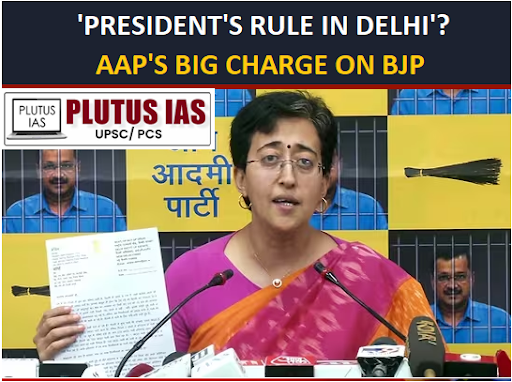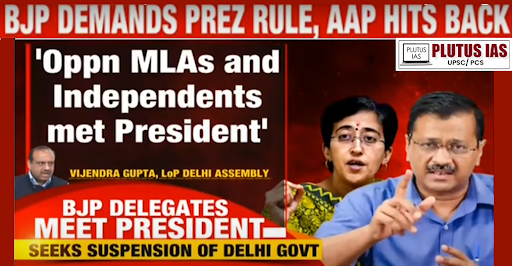17 Sep “President’s Rule: A Constitutional Safeguard or a Political Bludgeon?”
This article covers “Daily Current Affairs” and topic details of the emergency Provisions and their impacts on centre- states relations.
Syllabus mapping:
GS-2: Polity: Basic provisions of the constitution.
For Prelims:
What are the constitutional provisions related to the Emergency, and their impacts on centre-state relations, fundamental rights, and executive power?
For Mains:
How the Emergency provisions are used in the past and what are the consequences of the imposition of the emergency provisions and committee/commission recommendation on the use of the Emergency provisions?
Why in the News?
Recently the President of India forwarded the report on the imposition of the President’s rule in Delhi to the Union Home Ministry.

What is the Emergency?
Definition of Emergency:
The Emergency provisions in the Indian Constitution, are designed to empower the Central government to address exceptional circumstances. These provisions ensure the protection of the country’s sovereignty, unity, integrity, and security, as well as the democratic political system and the Constitution itself.
Constitutional Provisions: Articles 352 to 360 of Part XVIII of the Indian Constitution cover emergency provisions.
Types of Emergencies
1. National Emergency (Article 352).
2. President’s Rule or State Emergency (Article 356)
3. Financial Emergency (Article 360)
President’s Rule (Article 356):

Reasons for such provisions in the constitution:
Context of Partition: The Constitution framers, writing during the tumultuous period of Partition, were concerned about potential threats to national unity, including secession, ethnic conflict, and communist revolutions.
Central Authority: the constitution makers, vested the power to intervene in cases of severe law and order breakdown or constitutional governance failure with the Union government, rather than state Chief Ministers, to maintain national stability.
As Dead Letters: Despite anticipating possible abuse of these powers, Dr. B.R. Ambedkar acknowledged the risk of misuse and hoped such provisions would remain unused, referring to them as “dead letters.”
Grounds and Procedures for Imposing President’s Rule (Article 356):
Grounds for Imposition:
Article 356: The President can issue a proclamation if satisfied that a situation has arisen where a state’s government cannot be carried on according to the Constitution. This can be based on the governor’s report or other information.
Article 365: The President may also act if a state fails to comply with or give effect to directions from the Centre, leading to the conclusion that the state government cannot function according to the Constitution.
Parliamentary Approval and Duration:
Initial Approval: A proclamation of President’s Rule must be approved by both Houses of Parliament within two months from its issuance. If the Lok Sabha is dissolved or dissolved within this period, the proclamation remains in force until 30 days from the first sitting of the reconstituted Lok Sabha, provided the Rajya Sabha approves it.
Duration and Extensions: Once approved, the President’s Rule continues for six months and can be extended up to a maximum of three years, with Parliament’s approval every six months. If the Lok Sabha is dissolved during this period, the proclamation remains effective until 30 days after the new Lok Sabha’s first sitting, provided Rajya Sabha approval is maintained.
44th Amendment Act (1978):
Extension beyond one year requires:
1. A National Emergency must be in operation across India or in the concerned state.
2. The Election Commission must certify that elections cannot be held due to difficulties.
Revocation: The President can revoke a proclamation of President’s Rule at any time by issuing a subsequent proclamation, which does not require parliamentary approval.
Historical Use and Misuse:
Frequency and Controversy: Since 1950, the President’s Rule has been imposed over 125 times, averaging about twice per year. The use of Article 356 has been controversial and criticized, often being viewed as arbitrary and politically motivated.
Historical Examples: The first imposition of President’s Rule occurred in Punjab in 1951. By now, nearly all states have experienced a President’s Rule at least once.
Political Manipulation: After the 1977 Lok Sabha elections, the Janta Party, led by Morarji Desai, imposed President’s Rule in nine states where the Congress Party was in power, claiming the assemblies no longer represented the electorate. When the Congress Party returned to power in 1980, it imposed President’s Rule in nine states on similar grounds.
Consequences of President’s Rule:
1. Assumption of Powers: The President assumes the functions of the state government and the powers vested in the governor or any other state executive authority.
2. Administrative Actions: The President can take necessary steps, including suspending constitutional provisions relating to any state body or authority.
3. State Government: The President dismisses the state council of ministers, and the state governor, on behalf of the President, administers the state with the chief secretary or appointed advisors.
4. Legislative Assembly: The state legislative assembly may be suspended or dissolved. In such cases:
Law-Making: Parliament can delegate law-making powers to the President or another specified authority.
Budget and Laws: The Parliament, or delegated authority, can pass state legislative bills and the state budget.
Expenditure and Ordinances: The President can authorize expenditure from the state’s consolidated fund and promulgate ordinances when Parliament is not in session.
Criticism of the article 356:
Unprecedented Action: Article 356 allows unilateral Union intervention in state governance, a provision not seen in modern federal constitutions.
Doubt About Necessity: The relevance of Article 356 in contemporary India, 70 years post-independence, is increasingly questioned because of its misuse by the union government.
Contradiction to other provisions: Uttarakhand High Court’s Observation: The court viewed Article 356 as contrary to pure federalism, likening it to an intrusion into state affairs.
Originalist vs. Transformative View: The court’s defense based on the framers’ original intent is criticized for not adapting to modern contexts.
Changing Political Landscape: The need for Article 356 is less clear today, as the political environment has evolved since the post-partition era.
Moral and Ethical Concerns: Allowing the Union to intervene based on political disagreements or perceived anti-social elements challenges the principles of federalism and needs reassessment.
Solutions and recommendations:
1. Rare Use: The Sarkaria Commission recommends that Article 356 should only be invoked in rare and exceptional cases where no other options are viable.
2. Procedural Safeguards: The Sarakaria Commission provided some safeguards before invoking article 356 these are earning to states, assessment of governor report, and, avoiding dissolution of the state legalization.
3. Incorporation of Supreme Court Principles: The Puncchi Commission recommended integrating the principles from the Supreme Court’s S.R. Bommai v. Union of India (1994) decision into the Constitution.
5. Localized Emergency: It Punchhi Commission suggested implementing a “Localized Emergency” for troubled areas rather than imposing a blanket emergency across the entire state.
6. Duration of Emergency: The Punchhi Commission recommended that any emergency declared under this framework should be limited to a maximum of three months.
7. Reforms Relating to Anti-Defection Laws: This world helps to reduce the collapse of the government and the use of Article 356.
8. Independent role of the governor: The Governor plays a crucial role in declaring emergencies, as their reports are essential for presidential recommendations.
9. Last Resort: Article 356 should be used as a last resort, respecting B.R. Ambedkar’s intent for its rare application and upholding the people’s mandate.
10. Role of the judiciary: Ensure that the judiciary effectively balances the protection of democratic state governments with the need to uphold national security and integrity, as established in the S.R. Bommai case.
Conclusion
The Indian Constitution incorporates emergency provisions to address national crises, aiming to safeguard the country’s security, integrity, and stability. However, these provisions have sometimes been misused, leading to political manipulation and undermining democratic principles. It is crucial to exercise emergency measures with caution, strictly adhering to legal and procedural norms, to prevent their abuse and ensure that democratic values and constitutional integrity are maintained.
Download plutus ias current affairs eng med 17th Sep 2024
PRELIMS QUESTION:
Q. With reference to Article 356 of the constitution, consider the following statements:
1. The imposition of the president’s rule under Article 356 by the president of India, requires approval of the Union cabinet.
2. The parliament does not have any role in the revocation/imposition of the president rule in the state.
3. The defense ministry of the government of India can furnish a report for the imposition of the emergency under Article 356 in international border states.
How many of the above-given statements are correct?
A. Only one
B. Only two
C. All three
D. None
ANSWER: A
MAINS QUESTION:
How were the centre-state relations impacted by the imposition of the president’s rule in the state and what are the recommendations to make reasonable use of Article 356? Do you think that there is a need to amend Article 356 of the Constitution?
(250 words 15 marks)



No Comments